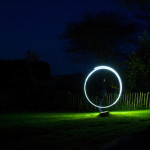We run our website the way we wished the whole internet worked: we provide high quality original content with no ads. We are funded solely by your direct support. Please consider supporting this project.

When Our Images of God are Faulty
I’m fleshing out the third proclamation of the ReKnew Manifesto, which challenges us to rethink our conception of God. In the previous post I noted that, since our relationship with God is mediated through our mental picture of him, our image completely determines how we feel about God and what our relationship with him will be like.
It’s no wonder that the first thing Satan attacked when tempting Eve in the Garden of Eden was her picture of God. Here’s how I interpret its depiction in the biblical narrative (Gen.3:1-5).
Out of love God placed the “Tree of the Knowledge of Good and Evil” in the Garden. As I argue in my book Repenting of Religion, this was God’s loving “No Trespassing” sign reminding Adam and Eve – and all of us — that we should never imagine we have the right or the capacity to judge others by our standards of “good” and “evil.” If we’re going to love like God loves – which is, I argue, the ultimate point of everything – we must always remember that God alone is the judge of the world. Unlike God, we can’t love and judge at the same time.
As he always does, Satan took God’s loving act and gave it his own diabolic spin. He told Eve that the reason God forbid her eating from the tree was because, “God knows that when you eat of it your eyes will be opened, and you will be like God, knowing good and evil” (Gen. 3:5). Satan painted a petty and untrustworthy picture of God. He made it seem like God was threatened by the potential the forbidden tree offered Eve.
Tragically, Eve believed the lie. Since her picture of God was no longer trustworthy, she stopped trusting God. Consequently, she felt she was on her own to become all she could be. So she violated God’s “No Trespassing Sign” and ate from the tree. And, as the saying goes, the rest is history.
However literal or figurative you interpret this narrative, its timeless teaching is that behind all human rebellion and sin is a faulty picture of God. As I discussed regarding the first proclamation of the ReKnew Manifesto, we are created with a vacuum in our soul that only God can fulfill. At the core of our being we crave a fullness of love, worth, significance and security that only our Creator can give. We have a hunger for fullness of LIFE, and it never goes away except insofar as we have a surrendered relationship to the one who is himself LIFE. All the beautiful plans God has for humans depend on our getting LIFE from God and God alone. Everything we are created to do is meant to be an expression of the LIFE we receive from God for free.
The trouble is, if we embrace an untrustworthy mental picture of God, we cannot enter into a LIFE-giving relationship with him. Consequently, our souls can’t help but crave LIFE, so we invariably try to get LIFE for ourselves on the basis of the things we accomplish, the possessions we acquire, the applause we get from others, the pleasures we experience, and so on. The Bible calls all such attempts to acquire LIFE “idolatry,” and it lies at the root of all sin.
The only way to get free of idolatry, and the only way to be empowered to love the way Jesus modeled for us to love, is to get all of our LIFE from God. And the only way we can do this is if we have an accurate, trustworthy, beautiful mental picture of God.
Everything God created us to be depends on the beauty and accuracy of your mental picture of God. So now the all-important question becomes: what authority do you trust to reveal to you what God is really like? The standard answer that Evangelicals give is, “the Bible.” In the next several blogs, I’m going to argue that this response is, at best, only partly correct.
Image by Elena Lagaria. Used in accordance with Creative Commons. Sourced via Flickr.
Category: General
Tags: Adam and Eve, Imagination, Picture of God, ReKnew
Related Reading

A ReKnew Website Primer
In many ways, the ReKnew website has become something like an introductory systematic theology resource centered around the beautiful God we find in Jesus. It is a resource that helps us rethink twelve core theological convictions. ReKnew invites you to: ReThink the Source of Life ReThink the Nature of Faith ReThink Our Picture of God…

Introduction to ReKnew
There’s never been anyone like Jesus. Not even close. And yet, there’s no greater disconnect in history than the chasm between Jesus and many who claim his name. If you’re like most thinking people, you’re frustrated by that. Or disappointed. The inconsistencies are rampant. Or maybe you’ve recently faced a horrific tragedy and your seemingly…

One Word
While I’ve lately been pretty distracted finishing up Benefit of the Doubt (Baker, 2013), my goal is to sprinkle in posts that comment on the distinctive commitments of ReKnew a couple of times a week. I’m presently sharing some thoughts on the second conviction of ReKnew, which is that Jesus Christ is the full and…

Getting Married or Buying a Car?
We’ve been slowly working our way through the ReKnew Manifesto. Currently, I’m offering some thoughts on the second of our convictions, which states that it’s time for us to rethink what we thought we knew about the nature of faith. Studies have shown that over 80% of Americans say that they believe they are “saved”…

Why Bart Ehrman Doesn’t Have to Ruin Your Christmas (Or Your Faith) Part 3
This is the third of several videos Greg put together to refute Bart Ehrman’s claims published in the article What Do We Really Know About Jesus? If you missed the first two installments you can find them here and here.

Who You Are Reflects the Kind of God You Worship
We always reflect the mental picture of God that we envision, for better or worse. If you have a fear-based picture of God, it will even affect the structure of your brain. You become the kind of person that you worship. If you have a threatening picture of God, you become threatening. If you have a…
